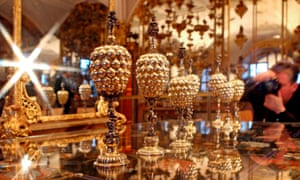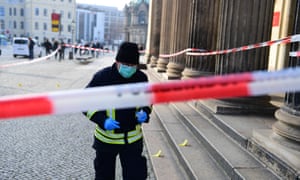Thieves in the German city of Dresden have broken into one of Europe’s largest collections of art treasures, making off with three sets of 18th-century jewellery of “immeasurable worth” in what German media has described as the biggest such theft since the second world war.
The dramatic heist took place at dawn on Monday, after a fire broke out at an electrical distribution point nearby, deactivating the museum’s alarm and plunging the area into darkness.
Despite the power cut, a surveillance camera filmed two men breaking into the Grünes Gewölbe (Green Vault) at Dresden’s Royal Palace.
Volker Lange, the head of Dresden police, said the thieves smashed a window and cut through a fence before approaching and breaking open a display cabinet in the Grünes Gewölbe’s Jewel Room in “a targeted manner”.
Officers were at the scene within minutes of being alerted to the robbery shortly before 5am local time, but the suspects had escaped. A burning car found in Dresden early on Monday may have been the getaway vehicle, police said. They have set up roadblocks on motorway approach roads around the city in an attempt to prevent the suspects from leaving. But the close proximity of the gallery to the autobahn is likely to have helped the thieves’ speedy escape, police said.
German media reported the losses from the burglary could run into the high hundreds of millions of euros, but the director of Dresden’s state art collections, Marion Ackermann, said it was impossible to estimate the value of the items.
“We cannot give a value because it is impossible to sell,” she said, appealing to the thieves not to break the collections into pieces. “The material value doesn’t reflect the historic meaning.”
Ackermann said the stolen items included three “priceless” sets of diamonds, including brilliant-cut diamonds which belonged to an 18th-century collection of jewellery assembled by the museum’s founder.
Created by Augustus the Strong, the Elector of Saxony, in 1723, the Grünes Gewölbe is one of 12 museums which make up the famous Dresden state art collections. It got its name because some rooms were decorated with malachite-green paint.
One of the oldest museums in Europe[1], the Grünes Gewölbe holds treasures including a 63.8cm figure of a Moor studded with emeralds and a 547.71-carat sapphire gifted by Tsar Peter I of Russia.
The museum is now made up of two sections, one historic and a newer part. It was the historic section, which contains around three-quarters of the museum’s treasures, that was broken into on Monday.
Entrance to the historic vault must be reserved in advance, and there is a strict limit on the number of daily visitors. Exhibits are arranged into nine rooms, including an ivory room, a silver gilt room and the central Hall of Treasures.
Michael Kretschmer, the leader of Saxony, of which Dresden is the capital, said he was devastated by the losses. “Not only the gallery has been robbed, but also the Saxonians,” he said. “You cannot understand the history of our country, or the free state of Saxony, without the Grünes Gewölbe and the state art collections of Saxony.”

The Grünes Gewölbe alone consists of 10 rooms teeming with about 3,000 items of jewellery and other masterpieces. The building was heavily damaged during the second world war but has been successfully restored, reopening to great international fanfare in 2006. It has been a tourist magnet since 1724, when it first opened to the public.
One of the museum’s most famous and precious treasures, the Dresden Green Diamond, is currently on loan with other valuable pieces to the Metropolitan Museum of Art in New York for an exhibition.
Saxony’s interior minister, Roland Wöller, said: “This is a bitter day for the cultural heritage of Saxony. The thieves stole cultural treasures of immeasurable worth – that is not only the material worth but also the intangible worth to the state of Saxony, which is impossible to estimate.”
Wöller said police had already set up a special team of investigators to pursue the case. “We will do everything in our power not only to bring the cultural treasures back, but to capture the perpetrators,” he said.
Leading international theft experts speculated about the thieves’ motives.
The Dutch “art detective” Arthur Brand, who made headlines earlier this month after uncovering a long-lost gold ring belonging to the writer Oscar Wilde, said the objects might have been stolen by people hoping to sell them, who would soon realise there was little hope of doing so.
“But the second and worst scenario would be professional robbers who just want the objects for their material value, the melted down gold or silver, who would take out the diamonds and sell them separately,” he told Der Spiegel. “But as soon as the works are destroyed, they are of course lost forever.”

Bernhard Pacher, manager of the art auction house Hermann Historica, told the tabloid Bild that if the objects stolen had a value of a billion euros, as initially estimated by police, “even when they are broken down and melted they can still deliver a 100-200 million euro return, which still makes it worth stealing them.”
Ackermann said that security at the state collections would now undergo a thorough review after what appeared to have been a meticulously planned heist.
“An incident like this naturally raises the question as to what can be improved, what can be done differently in future,” she said. “But there’s no such thing as 100% security.”
The theft is the second high-profile heist in Germany in recent years, after a 100kg, 24-carat gold coin was stolen from Berlin’s Bode Museum in 2017[4].
Agence France-Presse contributed to this report
World’s biggest heists
-
£100m diamond ‘heist of the century’
In 2003, £100m in diamonds were stolen from the Diamond Centre in Antwerp, Belgium. Some of the diamonds have since been recovered.
-
£90.5m Cannes film-like robbery
A thief in Cannes made off with over £90m in jewels in a 2013 smash and grab at a temporary exhibition in the Carlton Hotel, where Alfred Hitchcock filmed To Catch a Thief. The jewels have yet to be found.
-
£58m airport heist
In 2005, a £58m diamond theft took place at Amsterdam’s Schipol airport. Though the police have recovered some, £43m worth of diamonds are still unaccounted for.
-
£56m Paris theft
In 2008, Harry Winston’s boutique near Paris’ Champs-Elysees was raided by a group of men in make-up, who lifted £56m of gems and watches.
-
£40m Mayfair robbery
In 2009, Graff’s Diamond Store in Mayfair was stripped of its rings and diamonds worth more than £40m. It is likely that the jewels have been broken down and sold onto unregulated international markets. Oliver Taylor
References
- ^ Europe (www.theguardian.com)
- ^ Visual guide (interactive.guim.co.uk)
- ^ Graphic (interactive.guim.co.uk)
- ^ was stolen from Berlin’s Bode Museum in 2017 (www.theguardian.com)


No comments: